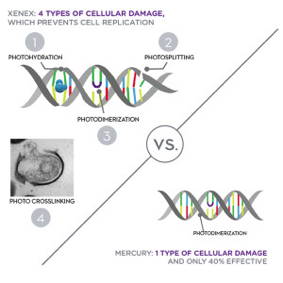 Cleanzine: your weekly cleaning and hygiene industry newsletter 18th April 2024 Issue no. 1110
Cleanzine: your weekly cleaning and hygiene industry newsletter 18th April 2024 Issue no. 1110
Your industry news - first
The original and best - for over 20 years!
We strongly recommend viewing Cleanzine full size in your web browser. Click our masthead above to visit our website version.
US Air Force hospital Langley adds Xenex Ebola-zapping robot to inventory
 Standing at 5 feet 2 inches tall, US Air Force Hospital Langley's newest staff member doesn't initially have a commanding presence. However, after five minutes, its impact has the potential to save countless lives around the world.
Standing at 5 feet 2 inches tall, US Air Force Hospital Langley's newest staff member doesn't initially have a commanding presence. However, after five minutes, its impact has the potential to save countless lives around the world.
The 633rd Medical Group recently received a germ-zapping robot, nicknamed 'Saul', which harnesses the power of technology to destroy viruses - including the Ebola virus.
Shortly after the president issued an executive order addressing the critical issue of Ebola, the 633rd MDG responded with cutting-edge technology to protect the health of the service members, their families and the community.
The hospital staff partnered up with Xenex Disinfection Services, the company that created Saul, as part of a response plan designated to ensure the 633rd MDG is equipped to handle viruses like Ebola.
"We are very proud to be the first Air Force hospital to acquire this robot for disease containment and Ebola virus preparedness," says US Air Force Col. Marlene Kerchenski, 633rd Medical Group Director of nursing services. "Saul will provide an extra measure of safety for both our patients and our intensive care unit staff."
Xenex offers what it says is the fastest, safest, and most cost-effective method for the disinfection of healthcare facilities, such as patient rooms, ORs, and ICUs. Xenex robots quickly destroy the microorganisms that cause healthcare associated infections, such asClostridium difficile (C.diff), Methicillin-resistant Staphylococcus aureus (MRSA) and the Ebola virus.
The Xenex germ-zapping robot works by pulsing xenon, an inert gas, at high intensity in a xenon ultraviolet flash lamp. This produces ultraviolet C (UVC), which penetrates the cell walls of microorganisms including bacteria, viruses, mould, fungus and spores. Their DNA is instantly fused so that they are unable to reproduce or mutate, effectively killing them on surfaces and in the air without contact or chemicals.
Although each room is cleaned by hospital staff wearing proper protection equipment and using cleaning chemicals, harmful bacteria, viruses and fungi still linger in some areas, especially those areas that human hands can't reach. As an additional patient safety measure, the Xenex robot can then disinfect a room in five minutes and destroy Ebola-like viruses on surfaces in two minutes.
"Saul is able to kill a single strand of ribonucleic acid, a virus similar to Ebola, two metres out in any direction, within five minutes at an efficiency rate of 99.9%," says Xenex representative Geri Genant. "Hospitals that are using Xenex's robots have been able to bring C.diff, MRSA and other DRO infection rates down in many cases by more than 60%."
The Xenex technology will be used at Langley as a preventative measure to help eradicate and control viruses. The robot will primarily be deployed for the disinfection of patient treatment areas including; in-patient rooms, operating rooms, isolation rooms, intensive care units, and common use areas. In addition, the robot is available to provide decontamination in response to a natural or intentional biological event. Xenex supports the 633rd MDG's medical readiness mission and provides an effective countermeasure to mitigate the risk of diseases such as Ebola from spreading.
The robots can be used to disinfect all areas where an infected patient will be transported or treated (aircraft, ambulances, ambulances, hospitals and personal protective equipment - PPE). Healthcare workers are vulnerable when they are removing their contaminated equipment (gowns, gloves, masks) after treating an Ebola patient. The robots can be used to quickly disinfect the PPE prior to removal so the workers are protected, which is a significant advancement in improving healthcare workers safety.
"The full spectrum UV technology in the Xenex robots directly supports the recently released Presidential Executive Order, 'Combating Antibiotic-Resistant Bacteria' and would be an outstanding course of action for DOD Military Treatment Facilities that were identified as needing to improve their infection prevention strategies by the SECDEF directed Military Health System Review," says Mark Storey, vice president of government accounts for Xenex.
"Xenex robots are considerably faster, safer and 'greener' than other automated cleaning and infection control methods, including toxic mercury UV and hydrogen peroxide-based systems, which can take multiple hours to achieve the same level of disinfection.
"UV light has been used for disinfection for decades - but not all UV light is the same. What sets Xenex apart is the robot's use of xenon (not toxic mercury) to create full spectrum UV light. Its patented technology is 25,000 times more intense than sunlight and hundreds of times more intense than mercury UV systems. This enables Xenex's germ-zapping robots to disinfect healthcare facilities in a fraction of the time it takes for mercury bulb devices to disinfect rooms.
"The Xenex germ-zapping robot can disinfect a typical patient/procedure room in 5 - 10 minutes, as demonstrated in multiple peer-reviewed published studies. The only non-mercury UV room disinfection solution is provided by Xenex."
The video story can be viewed at www.jble.af.mil
www.xenex.com
13th November 2014







